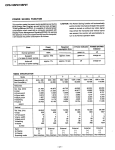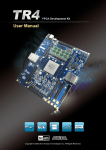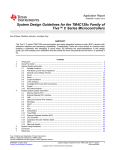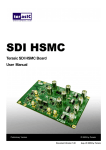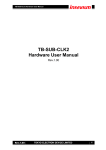Download TB-6S-LX150T-IMG2 Hardware User Manual
Transcript
TB-6S-LX150T-IMG2 Hardware User Manual TB-6S-LX150T-IMG2 Hardware User Manual Rev.1.02 Rev.1.02 1 TB-6S-LX150T-IMG2 Hardware User Manual Revision History Version Date Description Publisher Rev.1.00 2011/01/20 Initial Release. Yoshioka Rev1.01 2011/02/17 Modified register number of TDI/TDO connection of FMC Yoshioka Rev1.02 2011/03/15 Brash up all of sections. Modified configuration LED numbers Rev.1.02 Yoshioka 2 TB-6S-LX150T-IMG2 Hardware User Manual 1. 2. 3. 4. 5. 6. 7. Table of contents Related Documents and Accessories .......................................................................................... 9 Overview ...................................................................................................................................... 9 Feature......................................................................................................................................... 9 Block Diagram ........................................................................................................................... 10 External view of board ............................................................................................................... 11 Board Specifications .................................................................................................................. 12 Description of Components ....................................................................................................... 14 7.1. Power Supply Structure ........................................................................................................... 14 7.2. Oscillator .................................................................................................................................. 17 7.3. MGT reference clock ................................................................................................................ 19 7.3.1. PLL/MMCX_CLK_P/N ...................................................................................................... 19 7.3.1.1. 7.3.2. Clock Generator(CDCM61001RHBT) .......................................................................... 20 FB_CLEANUP_CLKP/N .................................................................................................. 21 7.3.2.1. 7.3.3. 7.4. 8. Clock Generator(ICS810001DK-21LF) ........................................................................ 21 MGT reference clock selector .......................................................................................... 22 FMC Connector Interface......................................................................................................... 23 7.4.1. HPC (High-Pin Count) ...................................................................................................... 24 7.4.2. LPC(Low-Pin Count) LPC1 .............................................................................................. 31 7.4.3. LPC (Low-Pin Count) LPC2 ............................................................................................. 35 7.5. DDR3 SDRAM ......................................................................................................................... 39 7.6. USB (UART)............................................................................................................................. 41 7.7. LED .......................................................................................................................................... 42 7.8. DIP Switch................................................................................................................................ 43 7.9. Push Button Switches .............................................................................................................. 44 7.10. Pin Header ........................................................................................................................... 45 7.11. Battery ...................................................................................................................................... 46 Appendix .................................................................................................................................... 47 8.1. Creating a Configuration File ................................................................................................... 47 8.2. Writing a Configuration File into the Flash Memory ................................................................. 52 8.3. Configuration Time ................................................................................................................... 58 8.4. Factory Switch and Jumpper Settings ..................................................................................... 59 Rev.1.02 3 TB-6S-LX150T-IMG2 Hardware User Manual List of Figures Figure 4-1 Block Diagram ................................................................................................................. 10 Figure 5-1 component side ............................................................................................................... 11 Figure 5-2 Solder side ...................................................................................................................... 11 Figure 6-1 TB-6S-LX150T-IMG2 board dimensions ......................................................................... 12 Figure 6-2 Hole positions .................................................................................................................. 13 Figure 7-1 Power Supply Structure................................................................................................... 14 Figure 7-2 Structure of the AC adapter input power connection ...................................................... 14 Figure 7-4 FPGA Banks and Peripheral Devices ............................................................................. 16 Figure 7-6 Clock Sources ................................................................................................................. 17 Figure 7-7 Clock Distribution Diagram.............................................................................................. 17 Figure 7-9 PLL/MMCX_CLK_P/N structure ...................................................................................... 19 Figure 7-10 FB_CLEANUP_CLKP/N structure ................................................................................ 21 Figure 7-13 VITA-57 Standard Low-Pin Count Connector ............................................................... 23 Figure 7-14 SDA, SCL, GA1/0 TDI/TDO .......................................................................................... 29 Figure 7-15 PG_C2M, PG_M2C,PRSNT_M2C_L............................................................................ 29 Figure 7-17 SDA,SCL,GA1/0 TDI/TD0 ............................................................................................. 33 Figure 7-18 PG_C2M,PRSNT_M2C_L ............................................................................................ 33 Figure 7-20 SDA,SCL,GA1/0 TDI/TD0 ............................................................................................. 37 Figure 7-21 PG_C2M,PRSNT_M2C_L ............................................................................................ 37 Figure 7-23 DDR3 SDRAM .............................................................................................................. 39 Figure 7-25 LED ............................................................................................................................... 42 Figure 8-1 Creating a Configuration File with ISE 12.2 .................................................................... 47 Figure 8-2 iMPACT Window 1 .......................................................................................................... 47 Figure 8-3 iMPACT Window 2 .......................................................................................................... 48 Figure 8-4 iMPACT Window 3 .......................................................................................................... 48 Figure 8-5 iMPACT Window 4 .......................................................................................................... 49 Figure 8-6 iMPACT Window 5 .......................................................................................................... 49 Figure 8-7 iMPACT Window 6 .......................................................................................................... 50 Figure 8-8 iMPACT Window 7 .......................................................................................................... 50 Figure 8-9 iMPACT Window 8 .......................................................................................................... 50 Figure 8-10 iMPACT Window 9 ........................................................................................................ 51 Figure 8-11 iMPACT Window 10....................................................................................................... 51 Figure 8-12 Onboard JTAG Connector............................................................................................. 52 Figure 8-13 Writing into the Device 1 ............................................................................................... 52 Figure 8-14 Writing into the Device 2 ............................................................................................... 53 Figure 8-15 Writing into the Device 3 ............................................................................................... 53 Figure 8-16 Writing into the Device 4 ............................................................................................... 54 Figure 8-17 Writing into the Device 5 ............................................................................................... 54 Figure 8-18 Writing into the Device 6 ............................................................................................... 55 Figure 8-19 Write into the Device 7 .................................................................................................. 55 Figure 8-20 Write into the Device 8 .................................................................................................. 56 Figure 8-21 Reconfiguration Switch ................................................................................................. 57 Figure 8-22 Configuration Status ...................................................................................................... 57 Figure 8-23 Changing Configuration Time ....................................................................................... 58 Figure 8-24 positions ........................................................................................................................ 59 Rev.1.02 4 TB-6S-LX150T-IMG2 Hardware User Manual List of Tables Table 7-1 Power status LEDs ........................................................................................................... 15 Table 7-2 FPGA Banks and Corresponding Devices........................................................................ 16 Table 7-3 Details of On board Oscillator ........................................................................................... 18 Table 7-4 PLL/MMCX_CLK_P/N setting ........................................................................................... 20 Table 7-5 Clock Generator(CDCM61001RHBT)IC settings ............................................................. 20 Table 7-6 Clock Generator (ICS810001DK-21LF) IC settings ......................................................... 21 Table 7-7 MGT reference clock settings ........................................................................................ 22 Table 7-8 HPC Column A & B Pin to FPGA Pin Assignment ............................................................ 24 Table 7-9 HPC Column C & D Pin to FPGA Pin Assignment ........................................................... 25 Table 7-10 HPC Column E & F Pin to FPGA Pin Assignment .......................................................... 26 Table 7-11 HPC Column G & H Pin to FPGA Pin Assignment ......................................................... 27 Table 7-12 HPC Column J & K Pin to FPGA Pin Assignment .......................................................... 28 Table 7-13 PG_C2M, PRSNT_M2C_L settings ................................................................................ 29 Table 7-14 LPC1 (CN3) Column C & D Pin to FPGA Pin assignment ............................................. 31 Table 7-15 LPC1 (CN3) Column G & H pin Pin to FPGA Pin assignment ....................................... 32 Table 7-16 PG_C2M, PRSNT_M2C_L settings ................................................................................ 33 Table 7-17 LPC2 (CN4) Column C & D Pin to FPGA Pin Assignment ............................................. 35 Table 7-18 LPC2 (CN4) Column G & H Pin to FPGA Pin Assignment ............................................. 36 Table 7-19 PG_C2M, PRSNT_M2C_L settigs .................................................................................. 37 Table 7-20 DDR3 SDRAM pin assignment ....................................................................................... 40 Table 7-21 UART pin assignment ..................................................................................................... 41 Table 7-22 Serial EEPROM SCL ...................................................................................................... 41 Table 7-23 LED pin assignment........................................................................................................ 42 Table 7-24 DIP Switch Pin Assignment ............................................................................................ 43 Table 7-25 Push Button Switch Pin Assignment............................................................................... 44 Table 7-26 Pin Header pin assignment ............................................................................................ 45 Table 8-1 Initial settings .................................................................................................................... 59 Rev.1.02 5 TB-6S-LX150T-IMG2 Hardware User Manual Introduction Thank you for purchasing the TB-6S-LX150T-IMG2 board. Before using the product, be sure to carefully read this user manual and fully understand how to correctly use the product. First read through this manual, and then always keep it handy. SAFETY PRECAUTIONS Be sure to observe these precautions Observe the precautions listed below to prevent injuries to you or other personnel or damage to property. • Before using the product, read these safety precautions carefully to assure correct use. • These precautions contain serious safety instructions that must be observed. • After reading through this manual, be sure to always keep it handy. The following conventions are used to indicate the possibility of injury/damage and classify precautions if the product is handled incorrectly. Danger Indicates the high possibility of serious injury or death if the product is handled incorrectly. Indicates the possibility of serious injury or death if the product is handled Warning incorrectly. Indicates the possibility of injury or physical damage in connection with houses or Caution household goods if the product is handled incorrectly. The following graphical symbols are used to indicate and classify precautions in this manual. (Examples) Turn off the power switch. Do not disassemble the product. ! Rev.1.02 Do not attempt this. 6 TB-6S-LX150T-IMG2 Hardware User Manual Warning In the event of a failure, disconnect the power supply. If the product is used as is, a fire or electric shock may occur. Disconnect the power supply immediately and contact our sales personnel for repair. If an unpleasant smell or smoking occurs, disconnect the power supply. If the product is used as is, a fire or electric shock may occur. immediately. Disconnect the power supply After verifying that no smoking is observed, contact our sales personnel for repair. Do not disassemble, repair or modify the product. Otherwise, a fire or electric shock may occur due to a short circuit or heat generation. For inspection, modification or repair, contact our sales personnel. ! Do not touch a cooling fan. As a cooling fan rotates in high speed, do not put your hand close to it. cause injury to persons. ! Otherwise, it may Never touch a rotating cooling fan. Do not place the product on unstable locations. Otherwise, it may drop or fall, resulting in injury to persons or failure. ! If the product is dropped or damaged, do not use it as is. ! Do not touch the product with a metallic object. ! Do not place the product in dusty or humid locations or where water may Otherwise, a fire or electric shock may occur. Otherwise, a fire or electric shock may occur. splash. Otherwise, a fire or electric shock may occur. ! ! Do not get the product wet or touch it with a wet hand. Otherwise, the product may break down or it may cause a fire, smoking or electric shock. Do not touch a connector on the product (gold-plated portion). Otherwise, the surface of a connector may be contaminated with sweat or skin oil, resulting in contact failure of a connector or it may cause a malfunction, fire or electric shock due to static electricity. Rev.1.02 7 TB-6S-LX150T-IMG2 Hardware User Manual Caution Do not use or place the product in the following locations. ! • Humid and dusty locations • Airless locations such as closet or bookshelf • Locations which receive oily smoke or steam • Locations exposed to direct sunlight • Locations close to heating equipment • Closed inside of a car where the temperature becomes high • Staticky locations • Locations close to water or chemicals Otherwise, a fire, electric shock, accident or deformation may occur due to a short circuit or heat generation. ! Do not place heavy things on the product. Otherwise, the product may be damaged. ■ Disclaimer This product is an evaluation board for Xilinx FPGA, Spartan6. Tokyo Electron Device Limited assumes no responsibility for any damages resulting from the use of this product for purposes other than those stated. Even if the product is used properly, Tokyo Electron Device Limited assumes no responsibility for any damages caused by: (1) Earthquake, thunder, natural disaster or fire resulting from the use beyond our responsibility, acts by a third party or other accidents, the customer’s willful or accidental misuse or use under other abnormal conditions. (2) Secondary impact arising from use of this product or its unusable state (business interruption or others) (3) Use of this product against the instructions given in this manual. (4) Malfunctions due to connection to other devices. Tokyo Electron Device Limited assumes no responsibility or liability for: (1) Erasure or corruption of data arising from use of this product. (2) Any consequences or other abnormalities arising from use of this product, or (3) Damage of this product not due to our responsibility or failure due to modification This product has been developed by assuming its use for research, testing or evaluation. It is not authorized for use in any system or application that requires high reliability. Repair of this product is carried out by replacing it on a chargeable basis, not repairing the faulty devices. However, non-chargeable replacement is offered for initial failure if such notification is received within two weeks after delivery of the product. The specification of this product is subject to change without prior notice. The product is subject to discontinuation without prior notice. Rev.1.02 8 TB-6S-LX150T-IMG2 Hardware User Manual 1. Related Documents and Accessories Related documents: All documents and reference designs relating to this board are available only for purchasing customers and can be downloaded from our website at Tokyo Electron Device Ltd. TED SUPPORT WEB (http://ppg.teldevice.co.jp/eng/index.htm). Mounting parts 7 x rubber foots, 14 x M3 X 6mm screws and 7 x M3 X 10mm spacers Accessories Option board spacer set: 6 x M2.6 X 10mm spacers (Duracon) and 12 screws with Duracon washers MMCX cable set: 2 x MMCX-SMA cables (Samtec RF174-03SP1-01SP1-0400) 2 x MMCX-MMCX cables (Samtec RF174-03SP1-03SP1-0400) AC adaptor 1 x AC adaptor (Akizuki Denshi: LTE(GFP)451DA-1238 or equivalents) 2. Overview ® The TB-6S-LX150T-IMG2 DDR3, 8 channel GTP, and Xilinx Spartan -6 evaluation board forms the base for numerous Spartan-6 development platforms including the Consumer Video Kit 2.0. 3. Feature - XC6SLX150T-3FG900 FPGA - 1 x VITA-57 standard FPGA Mezzanine Card (FMC) High Pin Count (HPC) connector - 2 x FMC Low Pin Count (LPC) connectors. Due to limitations on the number of FPGA pins, all defined FMC standard signals are not connected. For more information, refer to the Connector Pinout Tables in this manual on pages 24, 31, and 35. - 3 x DDR3 SDRAM (Chip): Micron MT41J64M16LA-15E(or equivalent) (1 Gbits 800Mbps) - 4 x 4 LVDS crosspoint switch - Clocks (see Figure 7-7 Clock Distribution Diagram) Multiple onboard clock sources (200 MHz, 27 MHz, 74.25 MHz) User populated clock chip in 8-pin dip External clock sources via single ended and differential MMCX connections with clock cleaners PLL clock generator programmable from the FPGA MMCX clock output DIP switch selectable MGT clock source selection - Push button switches, dip switches and pin headers - LEDs - USB connection to a PC (via USB-UART conversion device) for character based terminal I/O - 128 Mbit SPI Flash configuration ROM - TI TPS 386000 Voltage Supervisor Rev.1.02 9 TB-6S-LX150T-IMG2 Hardware User Manual 4. Block Diagram TB-6S-LX150T-IMG2 FMC_LPC1 (low-pin count) [Samtec] ASP-134603-01 FMC_LPC2 (low-pin count) [Samtec] ASP-134603-01 GC:2 pair/IO:34 pair ADR,CLK,CMD DDR SDRAM(1Gbit) [Micron] MT41J64M16LA-15E Data[0:15],DQS,DM ADR,CLK,CMD GC:2 pair/IO:34 pair DDR SDRAM(1Gbit) [Micron] MT41J64M16LA-15E Data[0:15],DQS,DM Differential signal is Input only ADR,CLK,CMD DDR SDRAM(1Gbit) [Micron] MT41J64M16LA-15E Data[0:15],DQS,DM GTP:CLK:4 pair/IO:16 pair LA:CLK:2 pair/IO:34 pair FMC_HPC (high-pin count) [Samtec] ASP-134486-01 MMCX Connector [Samtec] HA_HB:CLK:2 pair/HA_IO:24 pair, HB_IO:22 pair MMCX-J-P-H-ST-TH1 pair LVDS 4x4 CROSSPOINT SWITCH [TI] SN65LVDS250DBT 2pair pair pair LVDS BUFFER [TI] CDCLVD2102RGT OSC 74.25MHz [TamaDevice] CX104BC pair LVDS BUFFER [TI] CDCLVD2102RGT Option OSC [omron] XR2A-0811-N 4pair Dip Switch(8 poles) [omron] A6H-8101 pair FPGA [Xilinx] Spartan-6 MMCX Connector [Samtec] MMCX-J-P-H-ST-TH1 OSC 200MHz [TamaDevice] CL20VBC Level Shifter [TI] SN74AVC4T774 SPI FLASH [STMicroelectronics] M25P64-VMF6P XC6SLX150T -3FFG900 JTAG Connector [molex] 87831-1420 pair OSC 27MHz [TamaDevice] CX104BC Clock Generator [TI] CDCM61001RHBT pair Push Switch [omron] B3SN-3012 LVDS Buffer [TI] CDCLVD1204RGT MMCX Connector [Samtec] MMCX-J-P-H-ST-TH1 MMCX Connector [Samtec] Level shifter [TI] x2 SN74LVC2T45 Dip Switch(2 poles) [omron] A6H-2101 pair EEPROM [MICROCHIP] 24LC256I/P MMCX-J-P-H-ST-TH1 XTAL 27MHz [TamaDevice] HC-49/U MMCX Connector [Samtec] MMCX-J-P-H-ST-TH1 Dip Switch(4 poles) [omron] A6H-4101 Dip Switch(8 poles) [omron] A6H-8101 IC Socket [omron] XR2A-0811-N USB Connector [HIROSE] UX60-MB-5ST Resonator 12MHz [TamaDevice] HC-49U/S-SMD PinHeader (14 pin) [Samtec] TSM-114-01-L-DV CLK CLEANER [IDT] ICS810001DK-21LF Push Switch x4 [omron] B3SN-3012 Push Switch [omron] B3SN-3012 MMCX Connector [Samtec] USB-Serial IC [TI] TUSB3410RHB Dip Switch (10 poles) [omron] A6S-0104-H Clock Buffer [TI] CDCLVC1102PW LED x8 [AVAGO] HSMD-C191 MMCX-J-P-H-ST-TH1 Figure 4-1 Block Diagram Rev.1.02 10 TB-6S-LX150T-IMG2 Hardware User Manual 5. External view of board lock lock enerator Selector leanup lock n X Single ut _ P 1 onnector ow Pin ption S X ifferential nput Power V S 4x4 SSP T SW T 3S A P A e onfig SW _ P onnector igh Pin S 3S A S 200 X ifferential nput lash emory 4.25 Power US US S T SW _ P 2 onnector ow Pin ip SW JTA Push SW Pin eader K S T SW Figure 5-1 component side Figure 5-2 Solder side Rev.1.02 11 TB-6S-LX150T-IMG2 Hardware User Manual 6. Board Specifications External Dimensions: W: 240.00mm x H: 175.00mm Number of Layers: 12 layers Board Thickness: 1.6mm Material: FR-4 FPGA: Xilinx XC6SLX150T-3FGG900 PROM: ST Micro M25P64-VMF6P FMC Connector (High-Pin): Samtec ASP-134486-01 FMC Connector (Low-Pin): Samtec ASP-134603-01 DDR2 SDRAM: Micron MT41J64M16LA-15E MMCXConnector: Samtec MMCX-J-P-H-ST-TH1 Figure 6-1 TB-6S-LX150T-IMG2 board dimensions Rev.1.02 12 TB-6S-LX150T-IMG2 Hardware User Manual Figure 6-2 Hole positions Rev.1.02 13 TB-6S-LX150T-IMG2 Hardware User Manual 7. Description of Components 7.1. Power Supply Structure Figure 7-1 Power Supply Structure Power Input Power is supplied through the AC adaptor.. Figure 7-2 Structure of the AC adapter input power connection Rev.1.02 14 TB-6S-LX150T-IMG2 Hardware User Manual Power Status LED The board provides 13 LEDs to signal the correct operational status of each voltage rail. Table 7-1 Power status LEDs Voltage LED Description Color 12V LED1 12V power supply Blue 5.0V LED2 Power for 1.2/1.5/2.5V Red 1.2V LED3 Power for FPGA VCCINT Red M1+0.75V LED4 Power for FPGA VREF(DDR3) Red 2.5V LED5 Power for FPGA VCCIO Red 1.5V LED6 Power for FPGA VCCIO Red M2+0.75V LED7 Power for FPGA VREF(DDR3) Red OP+2.5V LED8 Power for FMC Red 1.2V_A1 LED9 Power for MGT AVCC1/AVTT1 Red M3+0.75V LED10 Power for FPGA VREF(DDR3) Red OP+3.3V LED11 Power for FMC Red 1.2V_A2 LED12 Power for MGT AVCC2/AVTT2 Red 3.3V LED13 Power for FPGA VCCIO Red Figure 7-3 Power status LED Rev.1.02 15 TB-6S-LX150T-IMG2 Hardware User Manual FPGA Bank Voltage Selection Various peripheral devices are connected to FPGA as shown in following figure. The FMC connectors allow the developers to select an appropriate FPGA Bank voltage (VCCIO) by setting the onboard jumpers (JP1, 2 and 3) to meet the voltage requirements (3.3V or 2.5V) for the connected FMC(HPC) CN5 interfaces. Figure 7-4 FPGA Banks and Peripheral Devices Table 7-2 FPGA Banks and Corresponding Devices Bank Function Bank0 FMC_HPC(CN5) Bank1 DDR3,DSW,LED,PSW,USB Bank2 FMC_HPC(CN5) Bank3 FMC_LPC1(CN3), FMC_LPC2(CN4) Bank4 DDR3 Bank5 DDR3 Voltage Voltage Selection SEL 2.5V 3.3V JP2 1-2 2-3 - - - JP3 1-2 2-3 JP1 1-2 2-3 1.5V - - - 1.5V - - - Selectable (3.3V/2.5V) 1.5V Selectable (3.3V/2.5V) Selectable (3.3V/2.5V) Selectable voltage is initially 2.5V settings Figure 7-5 Location of FPGA Bank Voltage Selection Rev.1.02 16 TB-6S-LX150T-IMG2 Hardware User Manual 7.2. Oscillator The board provides the following clock sources. Figure 7-6 Clock Sources Figure 7-7 Clock Distribution Diagram Rev.1.02 17 TB-6S-LX150T-IMG2 Hardware User Manual Table 7-3 Details of On board Oscillator connection name I/F FPGA PIN Remakes X1 CLK74.25M_P/N LVDS W5/W4 Single ended to differential signal buffer X2 CLK200M_P/N LVDS AJ17/AK17 DDR3(IDelay) clock X3 CLK_OPTION_P/N LVDS C16/A16 Single ended to differential signal buffer CN6/7 MMCX_P/N LVDS AH16/AK16 MMCX external clock IC32 (FB_CLEANUP_CLKP/N) or HPC_CLK_M101_P/N B13/A13 CN5(HPC_GBTCLK0_M2C_P/N) HPC_CLK_M245_P/N AJ13/AK13 or HPC_CLK_M123_P/N CN5(HPC_GBTCLK1_M2C_P/N) HPC_CLK_M267_P/N LVDS D18/C18 MGT reference clock AG18/AH18 or IC36(PLL/MMCX_CLKP/N) FMC_HPC(CN5) HPC_CLK0_M2C_P/N LVDS B15/A15 HPC_LA interface clock FMC_HPC (CN5) HPC_CLK1_M2C_P/N LVDS E16/D16 HPC_LA interface clock FMC_HPC (CN5) HPC_CLK2_M2C_P/N LVDS AC16/AD16 HPC_HA_HB interface clock FMC_HPC (CN5) HPC_CLK3_M2C_P/N LVDS AF16/AG16 HPC_HA_HB interface clock FMC_LPC1(CN3) LPC1_CLK0_M2C_P/N LVDS V4/V3 LPC1interface clock FMC_LPC1(CN3) LPC1_CLK1_M2C_P/N LVDS H15/G15 LPC1interface clock FMC_LPC2(CN4) LPC2_CLK0_M2C_P/N LVDS AA3/AA1 LPC2 interface clock FMC_LPC2(CN4) LPC2_CLK1_M2C_P/N LVDS AB2/AB1 LPC2 interface clock Supplementary explanation: HPC_CLK*_M2C_P/N and LPC*_M2C_P/N can be used for single-end signal. Rev.1.02 18 TB-6S-LX150T-IMG2 Hardware User Manual 7.3. MGT reference clock FPGA X5 LVDS 27MHz DIPSW SW6 DIPSW SW7 SEL SEL LVDS CDCM61001 (IC35) LVDS LVDS MMCX_P(CN10) MMCX_N(CN11) LVDS CDCLVD1204(I C36) LVDS FMC HPC LVDS PLL/MMCX_CLK_P/N FB_CLEANUP_CLKP/N LVDS CLK Cleaner ICS810001-21(IC33) MMCX_IN(CN9) MGT101 B13:MGTREFCLK0P_101 A13:MGTREFCLK0N_101 MGT123 D18:MGTREFCLK0P_123 C18:MGTREFCLK0N_123 MGT245 AJ13:MGTREFCLK0P_245 AK13:MGTREFCLK0N_245 CLK0 DIPSW SW4,5 LVCMOS33 Ctrl LVDS LVDS ICS8545-02(IC32) CLK1 CDCLVC1102 (IC31) MGT267 AG18:MGTREFCLK0P_267 AH18:MGTREFCLK0N_267 SN65LVDS250 (IC37) AH24:BANK2 MMCX_OUT(CN8) Figure 7-8 MGT reference clock structure 7.3.1. PLL/MMCX_CLK_P/N PLL/MMCX_CLK_P/N is input clock for “SN65LVDS250DBT”. This is selected MMCX_P/N(CN10, 11) or a clock generator(IC35: CDCM61001RHBT) by clock selector(IC36: CDCLVD1204RGT) and SW6(DIP-SW) The clock generator (IC35) uses 27MHz OSC(X5) for its master clock. Figure 7-9 PLL/MMCX_CLK_P/N structure Rev.1.02 19 TB-6S-LX150T-IMG2 Hardware User Manual Table 7-4 PLL/MMCX_CLK_P/N setting SW6 Selected clock 1 2 OUTP OUTN OFF OFF L H ON OFF MMCX OFF ON PLL Clock ON ON PLL Clock 7.3.1.1. Clock Generator(CDCM61001RHBT) This board uses a low jitter clock generator(TI CDCM61001RHBT). For more detail settings, please refer to the data sheet of CDCM61001RHBT. The output frequency and reset of clock generator is controlled by FPGA. It has 27MHz OSC for XIN. Table 7-5 Clock Generator(CDCM61001RHBT)IC settings Signal FPGA Pin No. Used for PR[1] AE26 Setting for pre-scaler divider and feedback divider PR[0] AE25 OD[2] Y23 OD[1] Y22 OD[0] AH27 RSTN Y24 Reset from FPGA OS[1:0] - OS[1:0] = 01 fixed CE - CE = 1fixed Setting for output divider Calculation for frequency of clock output Fout = VCO / Prescaler Divider / Output Divider For example: Generate 135MHz clock output. Conditions: Input clock is 27MHz (VCO=2025) PR[1:0] = OFF,ON (Prescaler Divider = 5, Feedback Divider = 15) OD[2:0] = OFF,ON,OFF(Output Divider = 3) Rev.1.02 20 TB-6S-LX150T-IMG2 Hardware User Manual 7.3.2. FB_CLEANUP_CLKP/N “FB_CLEANUP_CLKP/N” is differential input clock signal for the “SN65LVDS250DBT”. This differential signal is converted from single-ended to differential by IC32. The single-ended clock is generated by the IDT video clock generator (ICS810001DK-21LF). Figure 7-10 FB_CLEANUP_CLKP/N structure 7.3.2.1. Clock Generator(ICS810001DK-21LF) The board provides an onboard video clock generation circuit using the IDT ICS810001DK-21LF. For details about setting clock frequencies, refer to the corresponding IDT data sheet. This device accepts a clock sourced from the FPGA (AH24 pin) or from an external MMCX connector (CN9). The clock source selection is made via DIP switch SW5. The user selects the output clock frequency generated by this IDT video clock generator PLL via DIP switch SW5. The XTAL_IN is connected a 27MHz oscillator. A reset to this device occurs during power-up or by pressing pushbutton SW3. Table 7-6 Clock Generator (ICS810001DK-21LF) IC settings Signal V[3:0] SW No. SW4 SW bit Purpose bit[4:1] Input clock setting CLK_SEL bit[1] Input clock selection (ON=MMCX/OFF=FPGA) MF bit[2] PLL coefficient bit[4:3] Frequency dividing value: 00=4 / 01=8 / 10=12 / 11=18 nBP[1:0] bit[6:5] Output clock generation block structure setting OE bit[7] Output clock enable (ON=Enable) SW5 N[1:0] Output clock formula in nBP[1:0]=11(ON,ON): Fout = (in_CLK / P) x M x MF / N Rev.1.02 21 TB-6S-LX150T-IMG2 Hardware User Manual Example: 148.5MHz output Condition: Input clock: 27MHz (V[3:0]=ALL OFF=(P=1000)=(M=1000)) MF=OFF (x22) N[1:0]=OFF,OFF (divide-by-4 frequency) 7.3.3. MGT reference clock selector MGT reference clocks are selected by LVDS 4x4 crosspoint switch IC37 (TI: SN65LVDS250DBT). 4 clock sources are selected by SW7. Figure 7-11 MGT reference clock selector IC Table 7-7 OUTPUT CHANNEL 1 MGT reference clock settings OUTPUT CHANNEL 2 OUTPUT CHANNEL 3 OUTPUT CHANNEL 4 S10 S11 1Y/1Z S20 S21 2Y/2Z S30 S31 3Y/3Z S40 S40 4Y/4Z OFF OFF 1A/1B OFF OFF 1A/1B OFF OFF 1A/1B OFF OFF 1A/1B OFF ON 2A/2B OFF ON 2A/2B OFF ON 2A/2B OFF ON 2A/2B ON OFF 3A/3B ON OFF 3A/3B ON OFF 3A/3B ON OFF 3A/3B ON ON 4A/4B ON ON 4A/4B ON ON 4A/4B ON ON 4A/4B For example: Selecting FB_CLEANUP_CLKP/N to HPC_CLK_M123/245_P/N and HPC_GBTCLK0_M2C_P/N to HPC_CLK_M101/267_P/N. SW7 Rev.1.02 1: OFF 2: OFF 3: OFF 4: ON 5: OFF 6: OFF 7: OFF 8: ON 22 TB-6S-LX150T-IMG2 Hardware User Manual 7.4. FMC Connector Interface The board provides 3 Samtec FMC connectors. High-Pin Count : 1 (CN5) Low-Pin Count : 2 (CN3, CN4) Figure 7-12 and Figure 7-13 show the VITA-57 High-Pin Count and Low-Pin Count FMC pinouts respectively. Notice: Not all pins of the HPC and LPC connectors are connected to the FPGA. Figure 7-12 VITA-57 Standard High-Pin Count Connector Figure 7-13 VITA-57 Standard Low-Pin Count Connector Rev.1.02 23 TB-6S-LX150T-IMG2 Hardware User Manual 7.4.1. HPC (High-Pin Count) The FMC high-pin count connector connects the following number of signals to the FPGA: High Speed: 8 ch(TX), 8 ch (RX) and 2 clocks Low Speed: LA 34 pair (68 single-end) and 2 clocks. HA 24 pair (48 single-end) and 2 clocks (common of HA/HB). HB 22 pair (44 single-end). Table 7-8 HPC Column A & B Pin to FPGA Pin Assignment Bank No. Pin No. MGTRXP1_101 MGTRXN1_101 D12 C12 MGTRXP0_123 MGTRXN0_123 D20 C20 MGTRXP1_123 MGTRXN1_123 D22 C22 MGTRXP0_245 MGTRXN0_245 MGTRXP1_245 MGTRXN1_245 AG10 AH10 AG12 AH12 MGTTXP1_101 MGTTXN1_101 B11 A11 MGTTXP0_123 MGTTXN0_123 B21 A21 MGTTXP1_123 MGTTXN1_123 B23 A23 MGTTXP0_245 MGTTXN0_245 MGTTXP1_245 MGTTXN1_245 AJ9 AK9 AJ11 AK11 A GND DP1_M2C_P DP1_M2C_N GND GND DP2_M2C_P DP2_M2C_N GND GND DP3_M2C_P DP3_M2C_N GND GND DP4_M2C_P DP4_M2C_N GND GND DP5_M2C_P DP5_M2C_N GND GND DP1_C2M_P DP1_C2M_N GND GND DP2_C2M_P DP2_C2M_N GND GND DP3_C2M_P DP3_C2M_N GND GND DP4_C2M_P DP4_C2M_N GND GND DP5_C2M_P DP5_C2M_N GND 1 2 3 4 5 6 7 8 9 10 11 12 13 14 15 16 17 18 19 20 21 22 23 24 25 26 27 28 29 30 31 32 33 34 35 36 37 38 39 40 B RES1 GND GND DP9_M2C_P DP9_M2C_N GND GND DP8_M2C_P DP8_M2C_N GND GND DP7_M2C_P DP7_M2C_N GND GND DP6_M2C_P DP6_M2C_N GND GND *1 GBTCLK1_M2C_P *1 GBTCLK1_M2C_N GND GND DP9_C2M_P DP9_C2M_N GND GND DP8_C2M_P DP8_C2M_N GND GND DP7_C2M_P DP7_C2M_N GND GND DP6_C2M_P DP6_C2M_N GND GND RES0 PinNo. Bank No. AG22 AH22 MGTRXP1_267 MGTRXN1_267 AG20 AH20 MGTRXP0_267 MGTRXN0_267 *1 *1 *1 *1 AJ23 AK23 MGTTXP1_267 MGTTXN1_267 AJ21 AK21 MGTTXP0_267 MGTTXN0_267 *1: GBTCLK1_M2C_P/n can be assigned to reference clock of 4 MGT tiles by IC37. For more details, please refer to “7.3.3 NGT reference clock selector”. Rev.1.02 24 TB-6S-LX150T-IMG2 Hardware User Manual Table 7-9 HPC Column C & D Pin to FPGA Pin Assignment Bank No. MGTTXP0_101 MGTTXN0_101 MGTRXP0_101 MGTRXN0_101 Pin No. B9 A9 D10 C10 0 0 G18 F18 0 0 F15 E15 0 0 J13 H13 0 0 L14 K14 0 0 K19 J19 C GND DP0_C2M_P DP0_C2M_N GND GND DP0_M2C_P DP0_M2C_N GND GND LA06_P LA06_N GND GND LA10_P LA10_N GND GND LA14_P LA14_N GND GND LA18_P_CC LA18_N_CC GND GND LA27_P LA27_N GND GND *2 SCL *2 SDA GND GND *3 GA0 *6 12P0V GND *6 12P0V GND *6 3P3V GND 1 2 3 4 5 6 7 8 9 10 11 12 13 14 15 16 17 18 19 20 21 22 23 24 25 26 27 28 29 30 31 32 33 34 35 36 37 38 39 40 D *5 PG_C2M GND GND *1 GBTCLK0_M2C_P *1 GBTCLK0_M2C_N GND GND LA01_P_CC LA01_N_CC GND LA05_P LA05_N GND LA09_P LA09_N GND LA13_P LA13_N GND LA17_P_CC LA17_N_CC GND LA23_P LA23_N GND LA26_P LA26_N GND TCK *4 TDI *4 TDO *6 3P3VAUX TMS TRST_L *3 GA1 *6 3P3V GND *6 3P3V GND *5 3P3V Pin No. Bank No. *2 *2 *2 *2 F19 E19 0 0 F17 E17 0 0 J14 H14 0 0 G12 F12 0 0 M15 K15 0 0 H17 G17 0 0 M18 L18 0 0 *2: GBTCLK0_M2C_P/n can be assigned to reference clock of 4 MGT tiles by IC37. For more details, please refer to Figure 7-8 MGT reference clock structure Rev.1.02 25 TB-6S-LX150T-IMG2 Hardware User Manual Table 7-10 HPC Column E & F Pin to FPGA Pin Assignment Bank No. 2 2 Pin No. Y21 AA21 2 2 Y17 AA17 2 2 AB17 AD17 2 2 AE15 AF15 2 2 AC19 AD19 2 2 AD22 AE22 2 2 AA11 AB11 2 2 AC9 AD9 2 2 AF7 AG7 2 2 AG8 AH8 2 2 AD12 AE12 2 2 AJ15 AK15 Rev.1.02 E GND HA01_P_CC HA01_N_CC GND GND HA05_P HA05_N GND HA09_P HA09_N GND HA13_P HA13_N GND HA16_P HA16_N GND HA20_P HA20_N GND HB03_P HB03_N GND HB05_P HB05_N GND HB09_P HB09_N GND HB13_P HB13_N GND HB19_P HB19_N GND HB21_P HB21_N GND *6 VADJ GND 1 2 3 4 5 6 7 8 9 10 11 12 13 14 15 16 17 18 19 20 21 22 23 24 25 26 27 28 29 30 31 32 33 34 35 36 37 38 39 40 F *5 PG_M2C GND GND HA00_P_CC HA00_N_CC GND HA04_P HA04_N GND HA08_P HA08_N GND HA12_P HA12_N GND HA15_P HA15_N GND HA19_P HA19_N GND HB02_P HB02_N GND HB04_P HB04_N GND HB08_P HB08_N GND HB12_P HB12_N GND HB16_P HB16_N GND HB20_P HB20_N GND *6 VADJ Pin No. Bank No. W19 Y19 2 2 Y16 AB16 2 2 AC15 AD15 2 2 AE17 AF17 2 2 AE21 AF21 2 2 AE23 AF23 2 2 AB10 AB9 2 2 AD8 AE8 2 2 AG6 AH6 2 2 AD10 AE10 2 2 AE13 AF13 2 2 AC11 AD11 2 2 26 TB-6S-LX150T-IMG2 Hardware User Manual Table 7-11 HPC Column G & H Pin to FPGA Pin Assignment Bank No. 0 0 Pin No. E16 D16 0 0 F21 E21 0 0 H19 G19 0 0 H16 G16 0 0 G14 F14 0 0 J12 H12 0 0 M13 L13 0 0 J18 H18 0 0 M19 L19 0 0 L21 K21 0 0 J22 H22 0 0 F24 E24 Rev.1.02 G GND CLK1_M2C_P CLK1_M2C_N GND GND LA00_P_CC LA00_N_CC GND LA03_P LA03_N GND LA08_P LA08_N GND LA12_P LA12_N GND LA16_P LA16_N GND LA20_P LA20_N GND LA22_P LA22_N GND LA25_P LA25_N GND LA29_P LA29_N GND LA31_P LA31_N GND LA33_P LA33_N GND *6 VADJ GND 1 2 3 4 5 6 7 8 9 10 11 12 13 14 15 16 17 18 19 20 21 22 23 24 25 26 27 28 29 30 31 32 33 34 35 36 37 38 39 40 H *7 VREF_A_M2C *5 PRSNT_M2C_L GND CLK0_M2C_P CLK0_M2C_N GND LA02_P LA02_N GND LA04_P LA04_N GND LA07_P LA07_N GND LA11_P LA11_N GND LA15_P LA15_N GND LA19_P LA19_N GND LA21_P LA21_N GND LA24_P LA24_N GND LA28_P LA28_N GND LA30_P LA30_N GND LA32_P LA32_N GND *6 VADJ Pin No. Bank No. B15 A15 0 0 G20 F20 0 0 G22 F22 0 0 F23 E23 0 0 F13 E13 0 0 D24 C24 0 0 B25 A25 0 0 L17 K17 0 0 M20 L20 0 0 K20 J20 0 0 H21 G21 0 0 E25 D25 0 0 27 TB-6S-LX150T-IMG2 Hardware User Manual Table 7-12 HPC Column J & K Pin to FPGA Pin Assignment Bank No. 2 2 Pin No. AF16 AG16 2 2 AB21 AC21 2 2 AA19 AB19 2 2 AD18 AE18 2 2 AE19 AF19 2 2 AE24 AF24 2 2 AB20 AC20 2 2 AB12 AC12 2 2 AE9 AF9 2 2 AH7 AK7 2 2 AE11 AF11 2 2 AD14 AE14 Rev.1.02 J GND CLK3_M2C_P CLK3_M2C_N GND GND HA03_P HA03_N GND HA07_P HA07_N GND HA11_P HA11_N GND HA14_P HA14_N GND HA18_P HA18_N GND HA22_P HA22_N GND HB01_P HB01_N GND HB07_P HB07_N GND HB11_P HB11_N GND HB15_P HB15_N GND HB18_P HB18_N GND *8 VIO_B_M2C GND 1 2 3 4 5 6 7 8 9 10 11 12 13 14 15 16 17 18 19 20 21 22 23 24 25 26 27 28 29 30 31 32 33 34 35 36 37 38 39 40 K *7 VREF_B_M2C GND GND CLK2_M2C_P CLK2_M2C_N GND HA02_P HA02_N GND HA06_P HA06_N GND HA10_P HA10_N GND HA17_P_CC HA17_N_CC GND HA21_P HA21_N GND HA23_P HA23_N GND HB00_P_CC HB00_N_CC GND HB06_P_CC HB06_N_CC GND HB10_P HB10_N GND HB14_P HB14_N GND HB17_P_CC HB17_N_CC GND *8 VIO_B_M2C Pin No. Bank No. AC16 AD16 2 2 W20 Y20 2 2 AA18 AB18 2 2 AA22 AC22 2 2 AD20 AE20 2 2 AC24 AD24 2 2 AB23 AC23 2 2 W12 Y12 2 2 Y14 AA14 2 2 W14 Y13 2 2 AB13 AC13 2 2 AB14 AC14 2 2 28 TB-6S-LX150T-IMG2 Hardware User Manual * 1 GBTCLK0_M2C_P,N This signal is used for reference clock of MGT. * 2 SCL,SDA 2 The board provides test points TP32 and TP33 (with pullup resistors pad) to enable I C communications with the FPGA mezzanine card. Figure 7-14 SDA, SCL, GA1/0 TDI/TDO * 3 GA[1:0] The board has the above circuit design for notification of an ID to the FPGA mezzanine card. By default, the value is set to 00. * 4 TDI,TDO The board provides a loopback structure for JTAG communication from the FPGA mezzanine card. By default, this loopback function is not provided because the R510 resistor is not installed. * 5 PG_C2M, PG_M2C, PRSNT_M2C_L The board provides a structure to output to the FPGA mezzanine card. It also provides a similar structure for the column of F and H pins of the FMC connector. By default, it is set to open. The PG_M2C, PRSNT_M2C_L also has a similar structure. Figure 7-15 PG_C2M, PG_M2C,PRSNT_M2C_L Table 7-13 PG_C2M, PRSNT_M2C_L settings Rev.1.02 Pin No. Signal D1 Level settings H L PG_C2M R504 R505 F1 PG_M2C R517 R518 H2 PRSNT_M2C_L R523 R524 29 TB-6S-LX150T-IMG2 Hardware User Manual * 6 Power Supply The board provides a 12V output to the 12P0V pin and a 3.3V output to the 3P3V and 3P3VAUX pins. 3.3V and 2.5V output are also selectable for VADJ pins as shown in the following circuit diagram. The target FPGA pins are E39, F40, G39 and H40. The HPC_VADJ voltage supply is set by jumping across the identical pins on jumpers JP8 and JP9. The power status can be monitored by the adjacent LED. Caution: Do not jumper more than two portions of JP8 and JP9. Always jumper the same pins of both JP8 and JP9. Figure 7-16 VADJ *7 VREF_A_M2C,VREF_B_M2C The VREF_A_M2C terminal of the H1 pin can be monitored by TP36 and the VREF_B_M2C terminal of the K1 pin by TP34. *8 VIO_B_M2C The VIO_B_M2C terminal of each J39 and K40 pin can be monitored by TP35. Rev.1.02 30 TB-6S-LX150T-IMG2 Hardware User Manual 7.4.2. LPC(Low-Pin Count) LPC1 The FMC low-pin count connector connects the following number of signals: Low Speed: LA 34 pair (68 single-end) and 2 clocks. FPGA IO Bank3 cannot output LVDS signals. It is a limitation of the FPGA. Table 7-14 LPC1 (CN3) Column C & D Pin to FPGA Pin assignment Bank Pin No. 0 0 L11 K11 0 0 F11 E11 0 0 B7 A7 0 0 H7 G7 0 0 D6 C6 Rev.1.02 C GND DP0_C2M_P DP0_C2M_N GND GND DP0_M2C_P DP0_M2C_N GND GND LA06_P LA06_N GND GND LA10_P LA10_N GND GND LA14_P LA14_N GND GND LA18_P_CC LA18_N_CC GND GND LA27_P LA27_N GND GND *1 SCL *1 SDA GND GND *2 GA0 *6 12P0V GND *6 12P0V GND *6 3P3V GND 1 2 3 4 5 6 7 8 9 10 11 12 13 14 15 16 17 18 19 20 21 22 23 24 25 26 27 28 29 30 31 32 33 34 35 36 37 38 39 40 D *4 PG_C2M GND GND GBTCLK0_M2C_P GBTCLK0_M2C_N GND GND LA01_P_CC LA01_N_CC GND LA05_P LA05_N GND LA09_P LA09_N GND LA13_P LA13_N GND LA17_P_CC LA17_N_CC GND LA23_P LA23_N GND LA26_P LA26_N GND TCK *3 TDI *3 TDO *6 3P3VAUX TMS TRST_L *2 GA1 *6 3P3V GND *6 3P3V GND *6 3P3V Pin No. Bank No. M10 L10 0 0 K10 J10 0 0 G10 F10 0 0 D8 C8 0 0 H11 G11 0 0 F8 E8 0 0 E7 D7 0 0 31 TB-6S-LX150T-IMG2 Hardware User Manual Table 7-15 LPC1 (CN3) Column G & H pin Pin to FPGA Pin assignment Bank No. 0 0 Pin No. H15 G15 0 0 F6 E6 0 0 J8 H8 0 0 L12 K12 0 0 F9 E9 0 0 B6 A6 3 3 V2 V1 3 3 R7 R6 3 3 R5 R4 3 3 P4 P3 3 3 P2 P1 3 3 T2 T1 Rev.1.02 G GND CLK1_M2C_P CLK1_M2C_N GND GND LA00_P_CC LA00_N_CC GND LA03_P LA03_N GND LA08_P LA08_N GND LA12_P LA12_N GND LA16_P LA16_N GND LA20_P LA20_N GND LA22_P LA22_N GND LA25_P LA25_N GND LA29_P LA29_N GND LA31_P LA31_N GND LA33_P LA33_N GND *6 VADJ GND 1 2 3 4 5 6 7 8 9 10 11 12 13 14 15 16 17 18 19 20 21 22 23 24 25 26 27 28 29 30 31 32 33 34 35 36 37 38 39 40 H *5 VREF_A_M2C *4 PRSNT_M2C_L GND CLK0_M2C_P CLK0_M2C_N GND LA02_P LA02_N GND LA04_P LA04_N GND LA07_P LA07_N GND LA11_P LA11_N GND LA15_P LA15_N GND LA19_P LA19_N GND LA21_P LA21_N GND LA24_P LA24_N GND LA28_P LA28_N GND LA30_P LA30_N GND LA32_P LA32_N GND *6 VADJ Pin No. Bank No. V4 V3 3 3 U5 U4 3 3 U7 U6 3 3 N8 N7 3 3 M7 M6 3 3 T4 T3 3 3 T7 T6 3 3 P7 P6 3 3 N5 N4 3 3 N3 N 3 3 R R1 3 3 U3 U1 3 3 32 TB-6S-LX150T-IMG2 Hardware User Manual * 1 SCL,SDA 2 The board provides test points TP27 and TP28 (with pullup resistors pad) to enable I C communications with the LPC1 (CN3) FPGA mezzanine card. Figure 7-17 SDA,SCL,GA1/0 TDI/TD0 * 2 GA[1:0] The board has the above circuit design for notification of an ID to the FPGA mezzanine card. By default, the value is set to 01. * 3 TDI,TDO The board provides a loopback structure for JTAG communication from the FPGA mezzanine card. By default, this loopback function is not provided because the R448 resistor is not installed. * 4 PG_C2M, PRSNT_M2C_L The board provides a structure to output to the FPGA mezzanine card. By default, it is set to open. Figure 7-18 PG_C2M,PRSNT_M2C_L Table 7-16 PG_C2M, PRSNT_M2C_L settings Pin No. Signal D1 H2 Level settings H L PG_C2M R442 R443 PRSNT_M2C_L R440 R441 *5 VREF_A_M2C The board provides a test pad (TP26) to monitor the H1 pin (VREF_A_M2C) of the FMC connector. Rev.1.02 33 TB-6S-LX150T-IMG2 Hardware User Manual *6 Power Supply The board provides a 12V output to the 12P0V pin and a 3.3V output to the 3P3V and 3P3VAUX pins. 3.3V and 2.5V output are also selectable for VADJ pins as shown in the following circuit diagram. The LPC1_VADJ voltage supply is set by jumping across the identical pins on jumpers JP4 and JP5. The power status can be monitored by the adjacent LED. Caution: Do not jumper more than two portions of JP4 and JP5. Always jumper the same portion of JP4 and JP5. Figure 7-19 VADJ Rev.1.02 34 TB-6S-LX150T-IMG2 Hardware User Manual 7.4.3. LPC (Low-Pin Count) LPC2 The FMC low-pin count connector connects the following number of signals: Low Speed: LA 34 pair(68 single-end) and 2 clocks. FPGA IO Bank3 cannot output LVDS signals. It is a limitation of FPGA. Table 7-17 LPC2 (CN4) Column C & D Pin to FPGA Pin Assignment Bank No. Pin No. 3 3 AE4 AF4 3 3 AJ4 AK4 3 3 Y9 Y8 3 3 AB4 AB3 3 3 AF1 AG1 Rev.1.02 C GND DP0_C2M_P DP0_C2M_N GND GND DP0_M2C_P DP0_M2C_N GND GND LA06_P LA06_N GND GND LA10_P LA10_N GND GND LA14_P LA14_N GND GND LA18_P_CC LA18_N_CC GND GND LA27_P LA27_N GND GND *1 SCL *1 SDA GND GND *2 GA0 *6 12P0V GND *6 12P0V GND *6 3P3V GND 1 2 3 4 5 6 7 8 9 10 11 12 13 14 15 16 17 18 19 20 21 22 23 24 25 26 27 28 29 30 31 32 33 34 35 36 37 38 39 40 D *4 PG_C2M GND GND GBTCLK0_M2C_P GBTCLK0_M2C_N GND GND LA01_P_CC LA01_N_CC GND LA05_P LA05_N GND LA09_P LA09_N GND LA13_P LA13_N GND LA17_P_CC LA17_N_CC GND LA23_P LA23_N GND LA26_P LA26_N GND TCK *3 TDI *3 TDO *6 3P3VAUX TMS TRST_L *2 GA1 *6 3P3V GND *6 3P3V GND *6 3P3V Pin No. Bank No. W10 W9 3 3 AE5 AG5 3 3 AH3 AK3 3 3 AD7 AE7 3 3 Y2 Y1 3 3 AC3 AC1 3 3 AE3 AE1 3 3 35 TB-6S-LX150T-IMG2 Hardware User Manual Table 7-18 LPC2 (CN4) Column G & H Pin to FPGA Pin Assignment Bank No. 3 3 Pin No. AB2 AB1 3 3 Y7 Y6 3 3 AA7 AA6 3 3 AC6 AD6 3 3 AH5 AK5 3 3 AA10 AA9 3 3 W3 W1 3 3 AD2 AD1 3 3 AF3 AG3 3 3 AF2 AH2 3 3 AC5 AC4 3 3 V8 V7 Rev.1.02 G GND CLK1_M2C_P CLK1_M2C_N GND GND LA00_P_CC LA00_N_CC GND LA03_P LA03_N GND LA08_P LA08_N GND LA12_P LA12_N GND LA16_P LA16_N GND LA20_P LA20_N GND LA22_P LA22_N GND LA25_P LA25_N GND LA29_P LA29_N GND LA31_P LA31_N GND LA33_P LA33_N GND *6 VADJ GND 1 2 3 4 5 6 7 8 9 10 11 12 13 14 15 16 17 18 19 20 21 22 23 24 25 26 27 28 29 30 31 32 33 34 35 36 37 38 39 40 H *5 VREF_A_M2C *4 PRSNT_M2C_L GND CLK0_M2C_P CLK0_M2C_N GND LA02_P LA02_N GND LA04_P LA04_N GND LA07_P LA07_N GND LA11_P LA11_N GND LA15_P LA15_N GND LA19_P LA19_N GND LA21_P LA21_N GND LA24_P LA24_N GND LA28_P LA28_N GND LA30_P LA30_N GND LA32_P LA32_N GND *6 VADJ Pin No. Bank No. AA3 AA1 3 3 W7 W6 3 3 AB7 AB6 3 3 AJ2 AK2 3 3 AE6 AF6 3 3 W11 Y11 3 3 Y4 Y3 3 3 AH1 AJ1 3 3 AG4 AH4 3 3 AD4 AD3 3 3 AA5 AA4 3 3 V10 V9 3 3 36 TB-6S-LX150T-IMG2 Hardware User Manual * 1 SCL,SDA 2 The board provides test points TP30 and TP31 (with pullup resistors pad) to enable I C communications with the FPGA mezzanine card Figure 7-20 SDA,SCL,GA1/0 TDI/TD0 * 2 GA[1:0] The board has the above circuit design for notification of an ID to the FPGA mezzanine card. By default, the value is set to 10. * 3 TDI,TDO The board provides a loopback structure for JTAG communication from the FPGA mezzanine card. By default, this loopback function is not provided because the R472 resistor is not installed. * 4 PG_C2M, PRSNT_M2C_L The board provides a structure to output to the FPGA mezzanine card. By default, it is set to open. Figure 7-21 PG_C2M,PRSNT_M2C_L Table 7-19 PG_C2M, PRSNT_M2C_L settigs Pin No. Signal D1 H2 Settings H L PG_C2M R466 R467 PRSNT_M2C_L R464 R465 * 5 VREF_A_M2C The board provides a test pad (TP29) to monitor the H1 pin (VREF_A_M2C) of the FMC connector. Rev.1.02 37 TB-6S-LX150T-IMG2 Hardware User Manual * 6 Power Supply The board provides a 12V output to the 12P0V pin and a 3.3V output to the 3P3V and 3P3VAUX pins. 3.3V and 2.5V output are also selectable for VADJ pins as shown in the following circuit diagram. The LPC2_VADJ voltage supply is set by jumping across the identical pins on jumpers JP6 and JP7. The power status can be monitored by the adjacent LED. Caution: Do not jumper more than two portions of JP6 and JP7. Always jumper the same portion of JP6 and JP7. Figure 7-22 VADJ Rev.1.02 38 TB-6S-LX150T-IMG2 Hardware User Manual 7.5. DDR3 SDRAM The board provides three independent, 1 Gbit Micron DDR3 SDRAMs (MT41J64M16LA-15E) The following pins are connected: A[12:0], DQU[7:0], DQL[7:0],ODT, DQSU, /DQSU, DQSL, /DQSL, DMU, DML, CK, /CK, CKE, /RAS, /CAS, /WE, BA[2:0], /RESET /CS is hardwired low A[14], A[13] are memory address expansion bits. The board addresses 1 Gb using A[12:0]. Specifications 1Gbit (8Mword x 16bit x 8bank), 1066 (7-7-7) (Please refer to the Micron data sheet.) Address Structure Bank =3bit Address = 13bit (Row address = 13bit / Column address = 10bit) Data Bus Structure Each byte data strobe with write and read DQS Each byte data mask (DM) Figure 7-23 DDR3 SDRAM Rev.1.02 39 TB-6S-LX150T-IMG2 Hardware User Manual Table 7-20 DDR3 SDRAM pin assignment DDR3 Bank1 Bank4 Bank5 DDR3 Bank1 Bank4 Bank5 Pin Name (IC27) (IC28) (IC23) Pin Name (IC27) (IC28) (IC23) A0 U29 D4 D28 DQL0 Y26 H4 H28 A1 U30 D3 D30 DQL1 Y27 H3 H30 A2 T27 A3 C30 DQL2 AA27 J3 G29 A3 V28 E5 E29 DQL3 AA28 J1 G30 A4 R30 C5 F27 DQL4 W29 G3 G27 A5 V26 F2 H26 DQL5 W30 G1 G28 A6 V27 F1 H27 DQL6 Y28 H2 F28 A7 T26 B3 C29 DQL7 Y30 H1 F30 A8 P26 B2 B27 DQU0 AD28 M4 L27 A9 P27 A2 A27 DQU1 AD30 M3 L28 A10 R29 D5 F26 DQU2 AC27 L5 L29 A11 N28 G4 A26 DQU3 AC28 L4 L30 A12 P30 A4 B30 DQU4 AE29 L3 M26 A13 N29 B5 A28 DQU5 AE30 L1 M27 A14 N30 A5 A29 DQU6 AE27 M2 M28 BA0 T28 D2 D27 DQU7 AE28 M1 M30 BA1 T30 D1 C27 DQSL AA29 J5 J29 BA2 R28 F3 D26 DQSLN AA30 J4 J30 CK U27 E3 E27 DQSU AC29 K2 K28 CKN U28 E1 E28 DQSUN AC30 K1 K30 RASN W27 C1 K26 DML AB30 K3 J28 CASN W28 B1 K27 DMU AB28 K4 J27 CKE P28 C4 B29 RESETN N27 G5 C26 WE R27 F4 E26 RZQ M23 L7 G25 ODT V30 E4 E30 ZIO W24 J6 N24 Notice: Please refer to Xilinx answer record #34055 “MIG Spartan-6 FPGA MCB - What are the requirements for the RZQ and ZIO pins?” for information on how to use the peculiar signals RZQ/ZIO of the Memory Controller Block (MCB). The default setting of RZQ is 100 Ohm pull-down and /ZIO is N.C. Rev.1.02 40 TB-6S-LX150T-IMG2 Hardware User Manual 7.6. USB (UART) The board provides a MiniUSB B-Type interface connector (CN13) as a means to communicate between a computer terminal emulator (using the USB-RS232C conversion device (IC40) for bidirectional UART based communication) and the FPGA. JP10 enables the SCL pin of the USB-RS232C conversion device’s associated EEPROM. SW13 is the reset push button for IC40. Figure 7-24 USB (UART) Table 7-21 UART pin assignment Pin No. Signal Name Bank Y25 FP_RXD 1 AG26 FP_TXD 1 AH26 FP_CTS 1 AA25 FP_RTS 1 Level 1.5V Table 7-22 Serial EEPROM SCL JP10 Rev.1.02 connection 1-2 Short Connected 2-3 Short Un connected 41 TB-6S-LX150T-IMG2 Hardware User Manual 7.7. LED The board provides 8 onboard LEDs. These LEDs will light when the corresponding FPGA output pin is driven high. Figure 7-25 LED Table 7-23 LED pin assignment Device Rev.1.02 FPGA Name Signal Name Pin No. Bank LED26 LED1 R21 1 LED27 LED2 R22 1 LED28 LED3 AF28 1 LED29 LED4 AF30 1 LED30 LED5 P22 1 LED31 LED6 P23 1 LED32 LED7 AG29 1 LED33 LED8 AG30 1 Level 1.5V 42 TB-6S-LX150T-IMG2 Hardware User Manual 7.8. DIP Switch The board provides a 10 pole DIP switch. When a DIP switch is set to the ON side, it generates a high input to the associated FPGA pin. Figure 7-26 DIP Switch Diagram and Location Table 7-24 DIP Switch Pin Assignment Device Name SW8 Rev.1.02 FPGA Signal Name Pin No. Bank DSW1 P24 1 DSW2 P25 1 DSW3 AH30 1 DSW4 AJ30 1 DSW5 R24 1 DSW6 R25 1 DSW7 AJ29 1 DSW8 AK29 1 DSW9 T24 1 DSW10 T25 1 Level 1.5V 43 TB-6S-LX150T-IMG2 Hardware User Manual 7.9. Push Button Switches The board provides 4 push button switches. When a switch is depressed, it generates a high input to the associated FPGA pin. Figure 7-27 Push Button Switch Table 7-25 Push Button Switch Pin Assignment Device Rev.1.02 FPGA Name Signal Name Pin No. Bank SW9 PSW1 AJ28 1 SW10 PSW2 AK28 1 SW11 PSW3 U24 1 SW12 PSW4 U25 1 Level 1.5V 44 TB-6S-LX150T-IMG2 Hardware User Manual 7.10. Pin Header The board provides a 14 header connector (CN12). 8 pins are connected to the FPGA. Interface level is 1.5V. Figure 7-28 PinHeader Table 7-26 Pin Header pin assignment FPGA Pin Header Bank No. Pin No. Signal Name Signal Name Pin No. Bank No. - - 1.5V 1 2 1.5V - - 1 AG27 PH0 3 4 PH1 AG28 1 1 V23 PH2 5 6 PH3 V24 1 1 AD26 PH4 7 8 PH5 AD27 1 1 W21 PH6 9 10 PH7 W22 1 - - GND 11 12 GND - - - - - 13 14 - - - Rev.1.02 Pin No. FPGA 45 TB-6S-LX150T-IMG2 Hardware User Manual 7.11. Battery A Battery socket is not mounted on the solder side of the board at location CN2 Battery power is connected to VBATT (AB26) of FPGA. Please use “CR1220” size battery. Figure 7-29 Battery Rev.1.02 46 TB-6S-LX150T-IMG2 Hardware User Manual 8. Appendix 8.1. Creating a Configuration File This section describes how to create a configuration file using Xilinx ISE software version 12.2 Create a configuration file to write into the Flash memory. 1. Double-click Generate Target PROM/ACE File. Figure 8-1 Creating a Configuration File with ISE 12.2 2. Double-click Create PROM File. Figure 8-2 iMPACT Window 1 Rev.1.02 47 TB-6S-LX150T-IMG2 Hardware User Manual 3. Choose SPI Flash - Configure Single FPGA and then click the right-pointing arrow. Figure 8-3 iMPACT Window 2 4. On Storage Device (bits) select 64M and then click Add Storage Device. Figure 8-4 iMPACT Window 3 Rev.1.02 48 TB-6S-LX150T-IMG2 Hardware User Manual 5. Click the right-pointing arrow. Enter a name of directory and location in the Output File Name and Output File Location fields and then click OK. Figure 8-5 iMPACT Window 4 6. Click OK. Figure 8-6 iMPACT Window 5 Rev.1.02 49 TB-6S-LX150T-IMG2 Hardware User Manual 7. Select a bit file to create a configuration file. Figure 8-7 iMPACT Window 6 8. Click No. Figure 8-8 iMPACT Window 7 9. Click OK. Figure 8-9 iMPACT Window 8 Rev.1.02 50 TB-6S-LX150T-IMG2 Hardware User Manual 10. Double-click Generate File. Figure 8-10 iMPACT Window 9 11. If the configuration file has been successfully created, a message PROM File Generation Succeeded will appear. Figure 8-11 iMPACT Window 10 Rev.1.02 51 TB-6S-LX150T-IMG2 Hardware User Manual 8.2. Writing a Configuration File into the Flash Memory Connect a Platform USB cable to the JTAG connector (CN3) as shown in Figure 8-13. After powering on the board, start the ISE iMPACT applicaton and write a configuration file into the Flash memory by following the procedure described below. Figure 8-12 Onboard JTAG Connector 1. Double-click Boundary Scan and then click Initialize Chain shown by the arrow. Figure 8-13 Writing into the Device 1 Rev.1.02 52 TB-6S-LX150T-IMG2 Hardware User Manual 2. A bit/jed file configuration window will appear. Cancel it. Select an FPGA and right-click to select Add SPI/BPI FlashK. Figure 8-14 Writing into the Device 2 3. Select a configuration file (xxx.mcs) to write into the Flash memory. Figure 8-15 Writing into the Device 3 Rev.1.02 53 TB-6S-LX150T-IMG2 Hardware User Manual 4. Select the onboard Flash M25P64 and click OK. Figure 8-16 Writing into the Device 4 5. On the iMPACT Processes window double-click Program. Figure 8-17 Writing into the Device 5 Rev.1.02 54 TB-6S-LX150T-IMG2 Hardware User Manual 6. Click OK. Figure 8-18 Writing into the Device 6 7. The write operation into the Flash memory will start. Figure 8-19 Write into the Device 7 Rev.1.02 55 TB-6S-LX150T-IMG2 Hardware User Manual 8. If the write operation into the Flash memory is successfully completed, a message Program Succeeded will appear. Figure 8-20 Write into the Device 8 Rev.1.02 56 TB-6S-LX150T-IMG2 Hardware User Manual 9. The data written in the Flash memory device is used for FPGA configuration using Master-SPI. The FPGA configuration can be initiated either by turning on the power switch of the board or holding down the reconfiguration switch (SW2) for more than two seconds (see Figure 8-21 below). Figure 8-21 Reconfiguration Switch 10. The board provides two LEDs (15 and 16) for configuration status monitoring (see Figure 8-21 below). Green LED15 indicates that the configuration process has been successfully completed. Red LED16 indicates that the configuration process is in progress or failed. Figure 8-22 Configuration Status Rev.1.02 57 TB-6S-LX150T-IMG2 Hardware User Manual 8.3. Configuration Time Time required to load configuration data into the Flash memory device can be changed by setting the configuration clock on ISE Tool. Due to the operational frequency of SPI-Flash, select 16MHz or below. Method: 1. Right-click Generate Programming File 2. Choose Process Properties 3. Choose Configuration Options 4. Change the Value of Configuration Rate. Configuration Clock Frequency (MHz) Setting Figure 8-23 Changing Configuration Time Target for Configuration Time: Rev.1.02 Configuration Rate = 2MHz: Configuration Time = approx. 17 seconds Configuration Rate = 10MHz: Configuration Time = approx. 6 seconds 58 TB-6S-LX150T-IMG2 Hardware User Manual 8.4. Factory Switch and Jumpper Settings Figure 8-24 positions Table 8-1 Initial settings No. Silk No. Initial Setting Function 1 SW4,5 ALL OFF Setting for Video Clock 2 SW6,7 ALL OFF Clock select setting 3 SW8 ALL OFF User Dip SW 4 JP2 1-2 Bank0 IO Power setting (2.5V / 3.3V) 5 JP3 1-2 Bank2 IO Power setting (2.5V / 3.3V) 6 JP1 1-2 Bank3 IO Power setting (2.5V / 3.3V) 7 JP4,5 1-2 *FMC_LPC1 VADJ Power setting (2.5V / 3.3V / None) 8 JP6,7 1-2 *FMC_LPC2 VADJ Power setting (2.5V / 3.3V / None) 9 JP8,9 1-2 *FMC_HPC VADJ Power setting (2.5V / 3.3V / None) 10 JP10 1-2 Setting of serial EEPROM SCL (Connect / Disconnect) 11 JP22 1-2 SUSPEND Mode (Enable | Disable) *Bold character is factory setting. *Setting of the two jumpers must be the same position. Rev.1.02 59 TB-6S-LX150T-IMG2 Hardware User Manual PLD Solution Division URL: http://www.inrevium.jp/eng/x-fpga-board/ E-mail: [email protected] HEAD Quarter : Yokohama East Square, 1-4 Kinko-cho, Kanagawa-ku, Yokohama City, Kanagawa, Japan 221-0056 TEL:+81-45-443-4016 FAX:+81-45-443-4058 Rev.1.02 60





























































